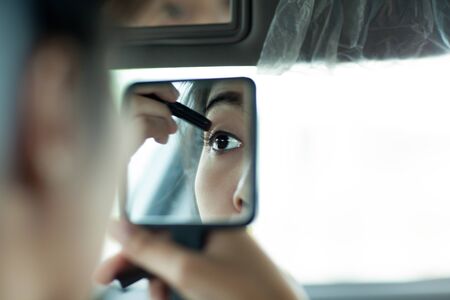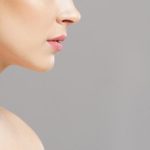1. Understanding the Aging Process and Facial Volume Loss
Aging is a natural process that affects every part of the body, including the face. Over time, changes in skin, fat, muscle, and bone structure contribute to volume loss, leading to noticeable signs such as under-eye hollows. Understanding these changes can help explain why the face loses its youthful fullness and how it impacts overall appearance.
How Aging Affects Facial Structures
As we age, several key factors contribute to volume loss in the face. These include fat redistribution, collagen depletion, and bone resorption. Each of these processes plays a role in creating hollowed areas, particularly around the eyes.
Fat Redistribution
Facial fat is naturally distributed in compartments throughout the face. When we are young, this fat is evenly spread, giving the face a plump and youthful look. However, with age:
- Fat pads shrink and shift downward due to gravity.
- The loss of fat in certain areas creates hollows under the eyes.
- Excess fat may accumulate in lower areas like the jowls.
Collagen and Elastin Depletion
Collagen and elastin are essential proteins that keep skin firm and elastic. As we get older:
- The body produces less collagen, causing skin to become thinner and less resilient.
- A decrease in elastin leads to sagging and fine lines.
- The combination of collagen loss and fat depletion makes under-eye hollows more prominent.
Bone Resorption
Bones provide structural support for facial features. However, aging also affects the bone structure:
- The orbital bone (eye socket) gradually recedes, making under-eye hollows appear deeper.
- The cheekbones lose density, reducing support for overlying tissue.
- This skeletal change contributes to an overall sunken look.
The Effects of Volume Loss on Under-Eye Hollows
The combined effects of fat loss, collagen depletion, and bone resorption make under-eye hollows more noticeable over time. This leads to a tired or aged appearance even when well-rested. The following table summarizes how different aging factors contribute to volume loss:
| Aging Factor | Effect on Under-Eye Hollows |
|---|---|
| Fat Redistribution | Lack of fat under the eyes creates hollowness and shadows. |
| Collagen Depletion | Thinner skin makes blood vessels more visible, enhancing dark circles. |
| Bone Resorption | The eye socket expands, causing deeper-looking hollows. |
The Importance of Addressing Volume Loss
A better understanding of facial aging allows for more effective solutions to restore lost volume. By targeting fat loss, collagen reduction, and bone changes, treatments can help bring back a youthful appearance while maintaining natural results. In the next section, we’ll explore common treatment options available for addressing under-eye hollows caused by aging.
2. Why Under-Eye Hollows Develop
Under-eye hollows can make a person look tired or older than they feel. But why do they form in the first place? Several key anatomical and physiological changes contribute to this common aging concern. Understanding these factors can help you explore the best ways to address them.
Genetics: The Role of Inherited Traits
Some people are genetically predisposed to under-eye hollows. If your parents or grandparents have deep-set eyes or naturally thin skin in this area, you may notice similar traits in yourself at an earlier age.
Skin Thinning: Loss of Collagen and Elasticity
As we age, our skin gradually loses collagen and elastin, the proteins responsible for maintaining firmness and elasticity. The delicate skin under the eyes is particularly vulnerable to thinning, making underlying structures more visible and contributing to a hollowed appearance.
Fat Pad Shifting: Changes in Facial Fat Distribution
Facial fat pads provide youthful volume and support, but over time, they shift and shrink. This redistribution of fat can create deeper grooves under the eyes, emphasizing hollowness and shadowing.
Key Factors Contributing to Under-Eye Hollows
| Factor | Description |
|---|---|
| Genetics | Inherited traits such as deep-set eyes or naturally thin skin can lead to early hollowing. |
| Skin Thinning | Collagen and elastin loss reduces skin thickness, making underlying structures more prominent. |
| Fat Pad Shifting | Aging causes facial fat pads to shrink and move, creating depressions under the eyes. |
Other Contributing Factors
Beyond aging and genetics, lifestyle choices such as poor diet, dehydration, excessive sun exposure, and lack of sleep can accelerate volume loss under the eyes. Maintaining a healthy skincare routine and staying hydrated can help slow down these changes.
What This Means for You
If youre experiencing under-eye hollows, understanding the underlying causes can guide you toward effective treatments. Whether through skincare, lifestyle adjustments, or professional procedures, there are options available to restore a more youthful appearance.
![]()
3. The Role of Collagen and Hyaluronic Acid in Skin Volume
As we age, our skin undergoes several changes that contribute to volume loss, especially under the eyes. Two key components responsible for maintaining skin structure and hydration are collagen and hyaluronic acid. Understanding their role can help explain why under-eye hollows become more prominent over time.
Collagen: The Skin’s Structural Support
Collagen is a protein that acts as the building block of our skin, providing strength and firmness. It forms a supportive network that keeps the skin plump and resilient. However, collagen production begins to decline in our mid-20s, and by the time we reach our 40s and 50s, this loss becomes more noticeable.
How Collagen Loss Affects the Under-Eye Area
- Thinner Skin: Reduced collagen makes the skin thinner, allowing blood vessels and hollow areas to become more visible.
- Less Firmness: Without adequate collagen, the skin loses its ability to bounce back, leading to sagging.
- Increased Wrinkles: Fine lines and wrinkles become more pronounced as structural support weakens.
Hyaluronic Acid: The Key to Hydration
Hyaluronic acid is a naturally occurring substance in our skin that helps retain moisture. It has the remarkable ability to hold up to 1,000 times its weight in water, keeping the skin hydrated and plump. Unfortunately, just like collagen, hyaluronic acid levels decrease with age.
The Impact of Hyaluronic Acid Decline
- Dehydration: Lower hyaluronic acid levels mean less moisture retention, making the under-eye area appear dry and sunken.
- Loss of Volume: Since hyaluronic acid contributes to skin fullness, its depletion leads to a more hollowed-out look.
- Dull Appearance: Proper hydration gives skin a healthy glow; without it, the under-eyes may appear tired and aged.
Aging Effects on Collagen and Hyaluronic Acid Levels
| Age Range | Collagen Production | Hyaluronic Acid Levels | Aging Impact on Under-Eyes |
|---|---|---|---|
| 20s | Slight decline begins | Naturally high | No significant volume loss |
| 30s | Noticeable reduction starts | Mild decrease | Slight hollowness may appear |
| 40s-50s | Dramatic decline | Significant drop | Puffiness or deep hollows become visible |
| 60s+ | Minimal natural production remains | Lack of moisture retention | Poor elasticity and pronounced hollows |
The Connection Between Aging and Under-Eye Hollows
The gradual decline of collagen and hyaluronic acid directly impacts how youthful or tired our under-eye area looks. With less structural support from collagen and reduced moisture retention from hyaluronic acid, the skin becomes thinner, drier, and more susceptible to volume loss. This combination often results in a sunken appearance that can make individuals look older than they feel.
4. Non-Surgical Treatments for Volume Restoration
Under-eye hollows can make the face look tired and aged, but non-surgical treatments offer effective solutions to restore lost volume and rejuvenate the area. Below are some of the most popular and minimally invasive options available.
Dermal Fillers
Dermal fillers are one of the most common treatments for under-eye hollows. These injectable gels, typically made from hyaluronic acid, help plump the skin and smooth out sunken areas.
Benefits of Dermal Fillers
- Immediate results with minimal downtime
- Hydrates and adds volume to the under-eye area
- Lasts anywhere from 6 to 18 months depending on the product used
Considerations
The procedure is quick, but there may be temporary swelling or bruising. Choosing an experienced injector is key to achieving natural-looking results.
PRP Therapy (Platelet-Rich Plasma)
PRP therapy uses your body’s own platelets to stimulate collagen production and improve skin texture. A small amount of blood is drawn, processed, and then injected into the under-eye area.
Benefits of PRP Therapy
- Promotes natural collagen production
- No risk of allergic reaction since it uses your own blood
- Improves skin quality over time
Considerations
This treatment requires multiple sessions for optimal results, and improvements appear gradually over several weeks.
Skin Boosters
Skin boosters are micro-injections of lightweight hyaluronic acid designed to hydrate and improve skin elasticity rather than create volume like traditional fillers.
Benefits of Skin Boosters
- Keeps the under-eye area hydrated and refreshed
- Smooths fine lines and improves skin texture
- A subtle enhancement that looks very natural
Considerations
The effects are more subtle compared to fillers, requiring multiple sessions for noticeable improvement.
Treatment Comparison
| Treatment Type | Main Benefit | Duration of Results | Pain Level |
|---|---|---|---|
| Dermal Fillers | Adds volume instantly | 6-18 months | Mild discomfort |
| PRP Therapy | Naturally stimulates collagen production | A few months (with multiple sessions) | Mild discomfort during blood draw & injection |
| Skin Boosters | Keeps skin hydrated & smooths fine lines | A few months (requires maintenance) | Mild discomfort with injections |
5. Long-Term Strategies for Preventing Under-Eye Hollows
Preventing under-eye hollows requires a combination of healthy lifestyle choices, a dedicated skincare routine, and professional treatments. By taking proactive steps, you can slow down the aging process and maintain youthful under-eye volume.
Lifestyle Changes for Healthier Skin
Daily habits play a significant role in preserving skin elasticity and preventing volume loss. Here are some key lifestyle changes to consider:
| Factor | Best Practices |
|---|---|
| Hydration | Drink at least 8 glasses of water daily to keep skin plump and hydrated. |
| Sleep | Aim for 7-9 hours of quality sleep per night to promote skin regeneration. |
| Diet | Consume antioxidant-rich foods like berries, leafy greens, and nuts to combat aging. |
| Avoid Smoking & Alcohol | Reduce smoking and alcohol intake as they accelerate collagen breakdown. |
| Sunscreen | Use SPF 30 or higher daily to protect the delicate under-eye area from UV damage. |
The Right Skincare Routine
A consistent skincare routine can help maintain under-eye volume by keeping the skin firm and nourished. Consider these essential steps:
- Cleansing: Use a gentle cleanser to remove dirt and makeup without stripping natural oils.
- Hydrating Eye Cream: Look for ingredients like hyaluronic acid, peptides, and ceramides to lock in moisture.
- Retinol: Helps boost collagen production and reduce fine lines over time.
- Sunscreen: Always apply sunscreen around the eyes during the day to prevent premature aging.
- Caffeine-Based Serums: Reduce puffiness and improve circulation under the eyes.
Professional Treatments for Long-Term Results
If lifestyle changes and skincare arent enough, professional treatments can provide long-lasting improvements. Some popular options include:
Dermal Fillers
This non-surgical treatment involves injecting hyaluronic acid fillers into the under-eye area to restore lost volume and smooth out hollows.
Laser Therapy
Treatments like fractional laser therapy stimulate collagen production, improving skin texture and reducing fine lines.
Chemical Peels
Mild chemical peels with ingredients like glycolic acid can help brighten the under-eye area and promote cell turnover.
Microneedling with PRP (Platelet-Rich Plasma)
This procedure uses tiny needles to create micro-injuries in the skin, stimulating collagen production while PRP enhances healing and rejuvenation.
A combination of these strategies—healthy habits, targeted skincare, and professional treatments—can significantly slow down aging-related volume loss, helping you maintain a youthful and refreshed appearance over time.


